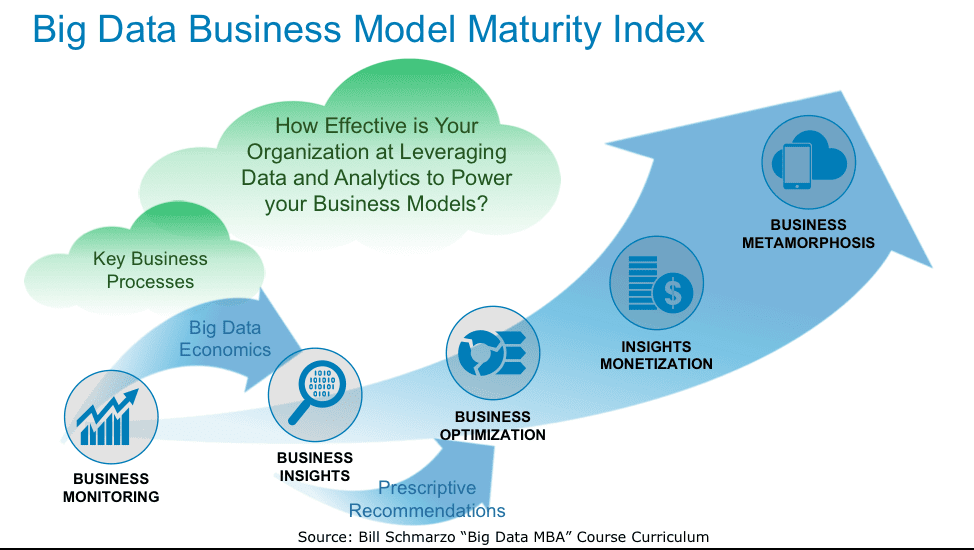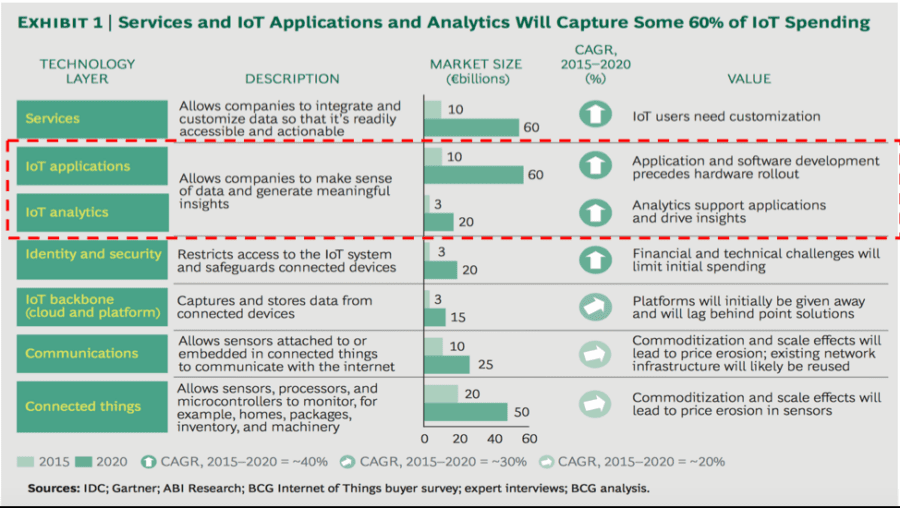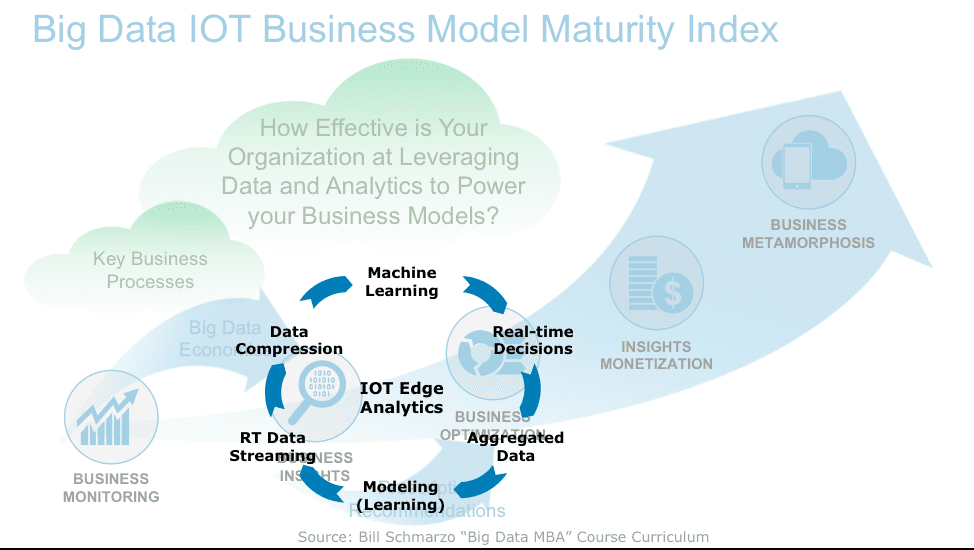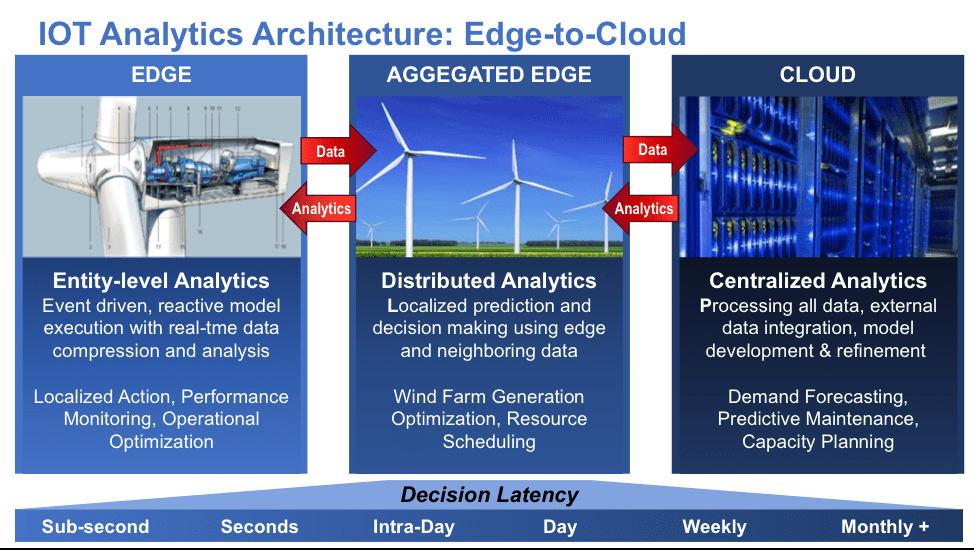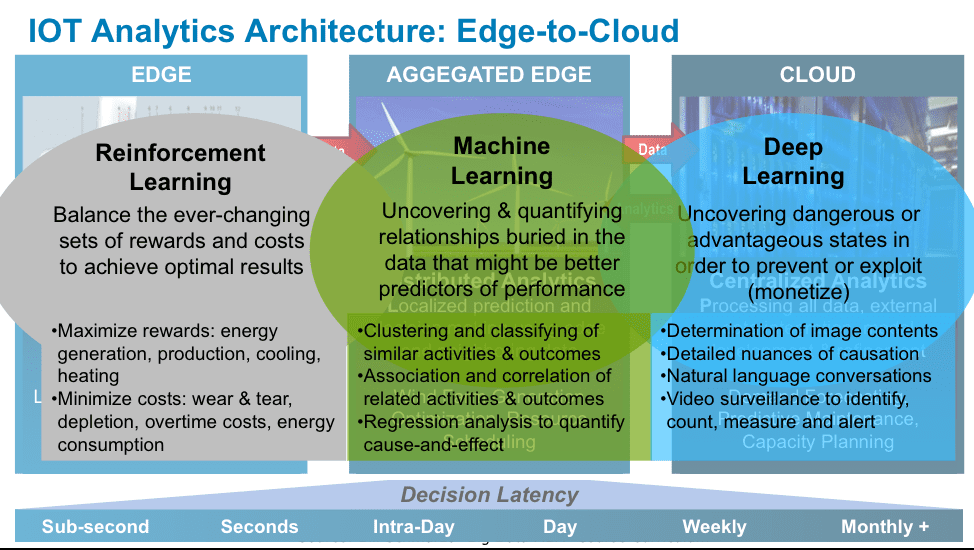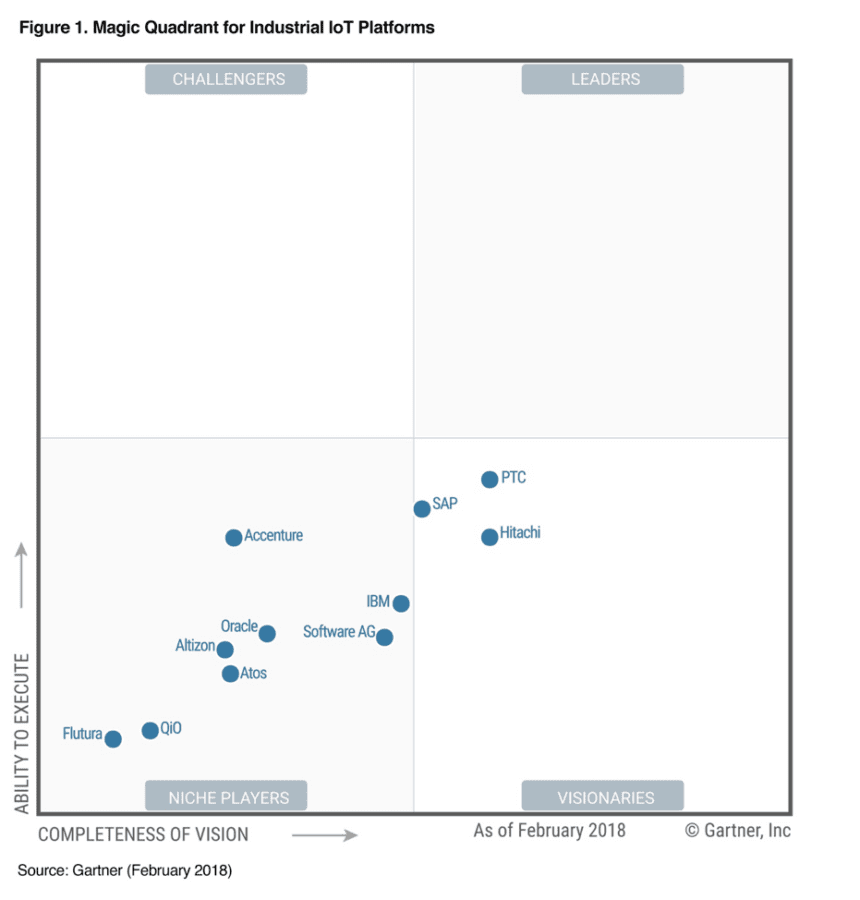Gartner’s recently released “Magic Quadrant for Industrial IoT Platforms” outlines how organizations can leverage the Internet of Things (IoT) to drive their digital transformation initiatives. In particular, Gartner believes that “By 2020, on-premises Internet of Things (IoT) platforms coupled with edge computing will account for up to 60% of industrial IoT (IIoT) analytics, up from less than 10% today.”[1]
More real-time sensor and device data coupled with more computational power are driving analytics “to the edge”, which will yield new business and operational monetization opportunities for organizations looking to become more effective at leveraging data and analytics to power their business models (see Figure 1).
Figure 1: Big Data Business Model Maturity Index
IoT will be a significant Digital Transformation enabler – enabling new opportunities to integrate digital capabilities into the organization’s assets, products and operational processes in order to improve efficiency, enhance customer value, mitigate risk, and uncover new monetization opportunities.
IoT value creation occurs when the IoT Analytics collide with IoT Applications (like predictive maintenance, manufacturing performance optimization, waste reduction, reducing obsolete and excessive inventory, and first-time-fix) to deliver measurable sources of business and operational value (see Figure 2).
This is a critical point that as a result of these IoT drivers, the Digital Transformation battlegroundwill move to the edgewhere real-time insights can be more quickly mined and acted upon.
Defining Edge Computing
Edge computing represents a shift in architecture in which intelligence is pushed from the cloud to the edge, localizing certain kinds of analysis and decision-making. Doing analytics closer to the edge of the ecosystem lets organizations analyze important data in near real-time – a growing need across many industries, including manufacturing, health care, transportation, energy, telecommunications, entertainment, sports and financial services.
An example of the IoT edge are SCADA (Supervisory Control and Data Acquisition) control systems. SCADA is a control system architecture that was designed for remote monitoring and control of industrial applications. SCADA uses programmable logic controllers (PLC), Remote Terminal Unit (RTU) and proportional–integral–derivative (PID) controllers to capture the data from the sensors embedded in machines and devices.
The data collection and analysis capabilities at the edge is becoming increasingly powerful and requires new real-time skill sets and capabilities including data capture, data integration, data aggregation and consolidation, and machine learning that will be mandatory in organizations looking to derive and drive value at the edge (see Figure 3).
Figure 3: IoT Edge Analytics Role in Deriving and Driving New Sources of Value Creation
The data capture, integration, management and analytics requirements at the edge are very different than the data and analytic requirements of a “traditional” big data/data lake-centric environment. Consequently, we need to broaden our analytics architecture – from edge-to-cloud– in order to identify and capture these new sources of value creation offered up by IoT.
IOT Analytics Reference Architecture
As Neil Raden from Wikibon stated in his report “Harvesting Value at the Edge”:
“IoT, though a useful application of available technology, and well-defined at the hardware and network levels, the heart of IoT, that part that yields the real value, is edge analytics. Making sense of the sensor data before it comes home. We already know how to stream massive amounts of data into data lakes for later analysis, but analytics at the edge begs a different approach.”
Organizations must think differently about their analytics architecture. There will be an edge component (where the real-time data is being generated and where immediate actions can yield significant tactical business and operational benefits), and there will be a cloud or core component (think Data Lake where all the data is gathered for more strategic analysis). However, there could also be several analytic tiers (n-tiers) in the middle that support distributed analytics amongst a group or federation or amalgamation of intermingled devices and machines.
How does one determine what analytics need to be located at what point across this n-tier analytic architecture? Simple. Look at the latency of the business and operational decisions – that is, how much time is necessary in order to make the business and operational decisions – and then place those analytics at the appropriate analytics tier (see Figure 4).
Figure 4: Decision Latency acrossIoT n-tiered Analytics Architecture
Identifying, validating, valuing and prioritizing the business and operational decisions (and their supporting use cases) will be a critical step in the IoT monetization process.
And not only do organizations need a more comprehensive analytics architecture, but they will need to master new advanced analytic algorithms at different points along that architecture in order to derive and drive new sources of business and operational value (see Figure 5).
Figure 5: Mapping Advanced Analytics to the IoT Analytics Architecture
From Reinforcement Learning to Machine Learning to Deep Learning, the role and importance of your data engineering and data science resources have never been more important.
Driving Digital Transformation with IoT Summary
Hitachi was recently positioned as one of three vendors in the Visionaries quadrant of Gartner’s inaugural “Magic Quadrant for Industrial IoT Platforms”. We believe this is a great validation of Hitachi’s vision for the Industrial IOT market (see Figure 6).
Figure 6: Gartner IoT Magic Quadrant
However, you can also see that no vendor was placed into the Leaders quadrant – IIoT vendors with both high “Completeness of Vision” combined with a high “Ability to Execute.” And that’s where we believe Hitachi is headed. With a strategy of co-creating industrial solutions with a select number of customers, Hitachi plans to lead the market with a solutions-centric approach that will define our product and services capabilities. And Digital Transformation at the edge will be at the heart of those co-creation efforts by helping those select customers to identify and capture new sources of customer, operational and market value creation.
It’s nice to be part of a race to the top.
This graphic was published by Gartner, Inc. as part of a larger research document and should be evaluated in the context of the entire document. Gartner does not endorse any vendor, product or service depicted in its research publications, and does not advise technology users to select only those vendors with the highest ratings or other designation. Gartner research publications consist of the opinions of Gartner’s research organization and should not be construed as statements of fact. Gartner disclaims all warranties, expressed or implied, with respect to this research, including any warranties of merchantability or fitness for a particular purpose.[1]Gartner “Magic Quadrant for Industrial IoT Platforms,” Eric Goodness, Ted Friedman, Peter Havart-Simkin, Emil Berthelsen, Alfonso Velosa, Saniye Burcu Alaybeyi, Benoit J. Lheureux, 10 May 2018

